October 26, 2018
Air Date: October 26, 2018
FULL SHOW
SEGMENTS
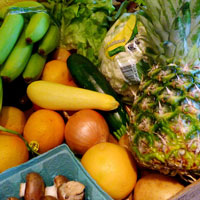
More Organics, Less Cancer
View the page for this story
Breast cancer rates were 35% less in older women and lymphomas were 70% less among high consumers of organic food, in a major study of nearly 69,000 persons conducted over seven years by French scientists and published in JAMA’s Internal Medicine Journal. The observed decrease in cancer risk is associated with organic food’s lack of pesticides, dyes and other additives, though more research is necessary to confirm these results and understand possible mechanisms. Ken Cook, President of the Environmental Working Group, joins Host Steve Curwood to consider consumer and research choices in light of this news. (07:52)
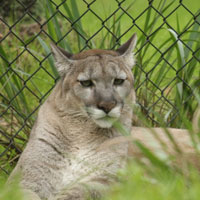
Beyond The Headlines
/ Peter DykstraView the page for this story
With professional baseball, football, hockey and basketball all active this past week in the United States, Peter Dykstra gives Host Steve Curwood an ecological scorecard for the real and sometimes endangered animals that are mascots for professional sports teams. Also, how some late-night comedians are choosing to poke fun at public perceptions of climate change. And an historical note about three grey whales that rose to celebrity status about three decades ago. (04:39)

Gaza Water Crisis
/ Sandy TolanView the page for this story
In the Mideast’s hotly contested Gaza Strip, where three out of four people are refugees, access to electricity and clean water is severely limited. The unsafe drinking water has led to a worsening health crisis for Gaza’s children, who suffer from diarrhea, kidney disease, stunted growth and impaired IQ. The problems include the lack of electricity to run Gaza’s sewage treatment plant, and the long-running conflict between Israelis and Palestinians. Sandy Tolan reports from the Gaza Strip. (18:31)
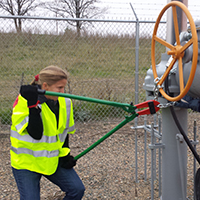
Acquitted For Climate Convictions
View the page for this story
Annette Klapstein and Emily Johnston knew they could face felony charges when they temporarily shut down two Enbridge tar sands oil pipelines in October of 2016. But these two ‘valve turners’ say they were compelled to engage in civil disobedience by the dire circumstances of our warming planet. In a conversation with Host Steve Curwood, they discuss their mixed feelings upon being acquitted of felony charges for damaging the pipelines without having the chance to present a climate necessity defense. (13:56)

BirdNote®: Saw-whet Owls Hoot And Hoot
/ Mary McCannView the page for this story
At less than three ounces, the Northern Saw-Whet Owl is one of the smallest owls in North America. But this tiny bird’s repetitive call, which sounds much like a vehicle backing up, can break through even the deepest slumber. BirdNote’s Mary McCann tells us more about the Northern Saw-Whet Owl and its autumn migration. (02:17)
Show Credits and Funders
Show Transcript
HOST: Steve Curwood
GUESTS: Ken Cook, Emily Johnston, Annette Klapstein
REPORTERS: Peter Dykstra, Mary McCann, Sandy Tolan
[THEME]
CURWOOD: From Public Radio International – this is Living on Earth.
[THEME]
CURWOOD: I'm Steve Curwood. Amid constant conflict between Palestinians and Israelis, a lack of safe water in the Gaza Strip is causing a humanitarian crisis.
BROMBERG: It's a ticking time bomb. Should pandemic disease break out in Gaza people will start moving to the fences. And they won't be moving with stones or with rockets they'll be moving with empty buckets desperately calling out for clean water.
CURWOOD: Also, a new study shows evidence of a relationship between eating organic foods and lower cancer rates.
COOK: What this study tells us is that, when it comes to the risks for cancer, an organic diet makes sense. A cleaner set of ingredients, closer to nature, fewer additives, less processing, is probably in general playing a role here.
CURWOOD: Those Stories and more this week on Living on Earth – Stick Around!
[NEWSBREAK MUSIC: Boards of Canada “Zoetrope” from “In A Beautiful Place Out In The Country” (Warp Records 2000)]
[THEME]
More Organics, Less Cancer
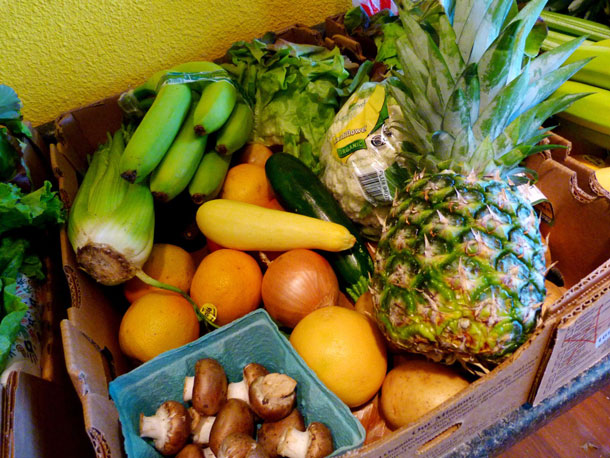
A massive study in France followed the diets of nearly 69,000 people and found that those who ate the most organic food over the seven years of the study were 25% less likely to develop cancer as compared to those who ate more conventional food. (Photo: Rusty Clark, Flickr, CC BY 2.0)
CURWOOD: From the Jennifer and Ted Stanley Studios at the University of Massachusetts Boston this is Living on Earth. I’m Steve Curwood.
A major study published in a Journal of the American Medical Association has found what many people have long suspected, eating organic food appears to reduce the risk of cancer. Among some 69,000 people tracked by French scientists over several years those whose diets contained more organics had about 25 percent fewer cancers overall, with 35 percent fewer breast cancers in older women and a more than 70 percent reduction in lymphomas. This study suggests but does not prove that pesticides and other chemical residues in food cause cancer. But there is no reason to wait for more research when it comes to making food choices, advocates say, including the President of the Environmental Working Group, Ken Cook. Ken, welcome back to Living on Earth!
COOK: Thanks, Steve. It's good to be here.
CURWOOD: So, when this study came out, it showed strong evidence in support of the long held belief that organic food is better for us. How do you feel now that this study is out there?
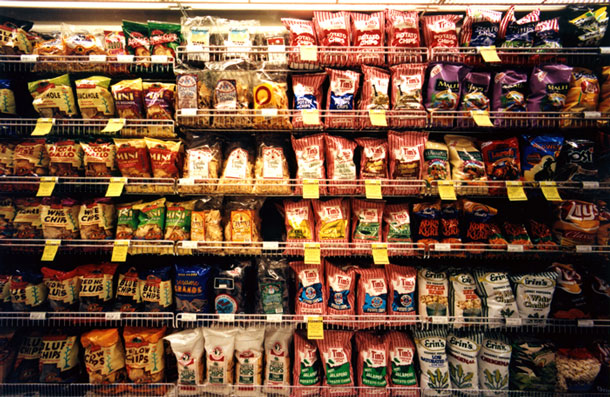
Diets with high amounts of organic produce may have more than a lack of pesticides to thank for their health benefits – organic food tends to leave out dyes, preservatives and additives found in other conventional foods. (Photo: Philosophographlux, Flickr, CC BY-NC-ND 2.0)
COOK: Well, I guess I feel as if we should have been doing studies like this a long time ago. We really do need to be much more careful about the low levels of carcinogens that we still have in our diet. The fact that several cancers here did show a marked decrease to me tells me that organic food is probably targeting the mechanisms that are associated with those cancers. And the other thing that's interesting, while they've spent about pesticides there are other chemicals in non organic food that are not allowed in organic - certain chemical dyes, certain colorings, certain flavorings - that simply are not allowed in organic food manufacture. That, in addition to pesticides may be another reason why there's lower cancer rates amongst these mostly women who are eating more organic food.
CURWOOD: And of course, if a product is made from genetically modified organisms, it's not allowed to be labeled as organic.
COOK: That is true as well, and they're really not very many chemicals that are allowed in organic manufacture or packaged food compared to conventional where there are thousands. So, there are lots of questions raised by this study, but to me it goes back to the basic point. A cleaner set of ingredients, closer to nature, fewer additives, less processing, is probably in general playing a role here.
CURWOOD: So, how excited are you by this study and how much of a game changer do you think it might become?
COOK: Well, I find it very encouraging. It's just one study that's often said from time to time, and they're right. One study is just one study. To me, this opens the door to doing more types of analyses like this of big populations and refine even further what we know about the diet of the people that are responding to the questions. What we need to do now, Steve, is we need to scale it up. We're still talking about organic with a very small footprint on the agricultural landscape, and unfortunately still a very small footprint as it were in our diet. But the other thing, I just have to say is, this does not mean that eating conventional fruits and vegetables is a bad thing. We think that's positive. The real problem when we have in our diet is the processed food, the additives, but this study adds that extra twist.

Avocados are one of the foods that made Environmental Working Group’s “Clean Fifteen,” a list of foods that, when tested, show a naturally low level of pesticides. (Photo: Rachel, Flickr, CC BY-NC 2.0)
CURWOOD: Some people are going to be surprised that you say go ahead eat conventional fruits and vegetables that have pesticides on them because they're less of a risk than other things that we put in our bodies.
COOK: Yeah, that's right but, you know, if I can give my little boy a conventional apple I'm going to give him that as opposed to a pile of cookies or some chips. And so, I think we want to move the diet lower down in the food chain to plants - a plant-based diet is desirable - but we don't have to choose. We want people to think holistically about their health and their diet, and in order to do that we have to recognize that not everyone can find or afford organic food.
CURWOOD: So, every year you guys publish a list of foods which are kind of, ooh, worried about the pesticides and then the things that you like. Mention some of those items to us now.
COOK: Well, sure. I mean every year we look at the data that comes out of the Department of Agriculture. They test our fruits and vegetables for pesticides, and we look at a couple of things. We look at how many pesticides and what concentration they are in fruits and vegetables. So, we've come up with two lists. One is the dirty dozen. These are the fruits and vegetables that have the most pesticides on them, and if you want to avoid pesticides, you should try and buy organic of those types of foods. Then there's the clean 15, which we started doing some years ago because we were concerned that organic wasn't always available and we also want to incentivize people to get them thinking positively about eating fruits and vegetables. These are things like bananas, certain types of squash, where the pesticide levels are extraordinarily low, they almost seem as if they're organic.
CURWOOD: The study published in "The Journal of the American Medical Association Internal Medicine" talks about cancer being associated with consumption of non organic food, or the other way around is that the more organic you eat the less likely you are to get cancer. From your research and studies over the years, which of these findings really resonate with what you've been told by other scientists, in particular the types of cancer?
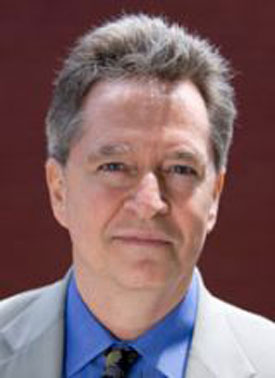
Ken Cook is the President and Cofounder of Environmental Working Group. (Photo: Courtesy of Environmental Working Group)
COOK: These are exactly the kinds of cancers that we would be concerned about with these exposures, and while this study focused on cancer, it also made me wonder the benefits we might see or the understandings we might reach if they did a similarly large study of this sort and looked at other disease outcomes, neurological diseases, ADHD, early onset Alzheimer’s, any kind of damage to our nervous system. We have a lot of pesticides that are in use and are in the food supply that have that particular health end point associated with them, while with others it is cancer. So, again I think the overarching message here is that when you look at a large population like this and you ask a lot of smart thoughtful questions about eating habits, we emerge with a fresh understanding of the benefits of having a diet that is clean.
CURWOOD: Why haven't we see this kind of study out of the United States, do you think?
COOK: I think we may see interest in doing a study such as this in the United States now, but what I will say is we know that the other side of this debate in the chemical industry has not been eager to have these kinds of studies conducted and simply wants to reassure everyone that whatever is in your food now is safe because the government says so. And that's the backdrop here. We have science that tells us that there are sometimes very subtle, sometimes long-term effects on our health from exposure to pesticides and other toxic chemicals, and because the exposure only manifests itself decades later, it's very difficult to get a handle on those, and because the government often doesn't regulate them, it leaves people thinking well perhaps there's not much to it after all.
Studies like this breakthrough and you suddenly realize, ah-ha, all along our hypothesis was probably right. You put chemicals in food that even at trace levels are considered carcinogenic or could mess with our nervous system our hormone system. Over time, it could have an effect but you need a very powerful study to draw out those conclusions. This is one such study and I think there may be more that follow now.
CURWOOD: Ken Cook is the President of the Environmental Working Group. Ken, thanks so much.
COOK: Steve, thank you.
Related links:
- The original article in JAMA’s Journal, Internal Medicine
- Environmental Working Group: Massive Study Finds Eating Organic Slashes Cancer Risk
- The Environmental Working Group’s shopper guide for the ‘Dirty Dozen’ and ‘Clean Fifteen.’
- About Ken Cook, Environmental Working Group President
- CNN | “You Can Cut Your Cancer Risk by Eating Organic, a New Study Says”
- New York Times | “Can Eating Organic Food Lower Your Cancer Risk?”
[MUSIC: Paula Fuga, “Beautiful Face” on Lilikoi, Punahele Productions]
Beyond The Headlines
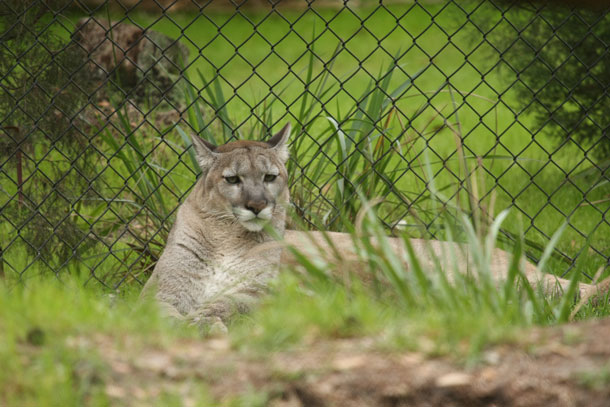
The Florida Panthers (as in, the furry, four-legged ones) have made a comeback in recent years. (Photo: DGriebeling, Flickr CC BY 2.0)
CURWOOD: Hey let’s take a look beyond the headlines now with Peter Dykstra, he’s an editor with Environmental Health News, that’s EHN.org and the Dailyclimate.org on the line now from Atlanta, Georgia. Hey there Peter, what do you got for us today?
DYKSTRA: Hi Steve. We’re going to do something a little different and take a look at sports.
CURWOOD: Okay.
DYKSTRA: Because October is peak season for American sports. The World Series of course, college and professional football are in the middle of their seasons, and pro basketball and pro hockey are underway. It’s probably the best time to point out that some of our favorite sports teams have appropriated vanishing species as their mascots and nicknames. One of my favorites: The Wolverines from the University of Michigan when no actual wolverines have been spotted in the state of Michigan since the mid 1800s.
These teams and colleges make millions on merchandise licensing, on television revenues, on ads and everything else. The same thing for teams named after tigers and timber wolves and of course, the National Hockey League’s San Jose Sharks. But my all-time favorite are the Florida Panthers, also in the National Hockey League. 23 guys on the Panther’s roster and there were about that many real Florida panthers in the wild in the everglades not too long ago. But some good news – the four-legged Florida panthers have rebounded.
CURWOOD: Wait a minute – I thought basketball teams rebounded.
DYKSTRA: Ah, not in this analogy. But why can’t most of us care about species rather than just the teams named after them?
CURWOOD: Hey, what else do you have for today?
DYKSTRA: Well a little humor, because climate change, as we all know, is as hilarious as it is widely covered by TV news.
CURWOOD: You mean Peter, it’s neither one.
DYKSTRA: Well a week ago it was both funny and widely covered. Funny because the coverage I’m talking about was on late-night comedy shows. Like this one, where Trevor Noah talked about a new report that says climate change will raise the price of beer.
NOAH: Aw man, they're trying so hard to get people to care about climate change. Right now, because if you tell Americans that in 10 years the Marshall Islands could be underwater, no one cares, but tell them that Corona will cost more now they're marching in the streets, C’mon!
[LAUGHS]
CURWOOD: [CHUCKLES] Okay.
DYKSTRA: Now we’ve got this one from the Late Show With Steve Colbert. Rather than talking about just how unformed the general public is, we go to the White House where he’s misinformed.
COLBERT: And after a year of massive storms and our glaciers just shrinking in every direction, Trump was still ambivalent on the concept of climate change. He told the reporter, 'you have scientists on both sides of the issues' -- that is true, no, that is true -- there are scientists on both sides! On one side, all the scientists, on the other, one guy who runs a blog called, "Realtrueamericanscienceeagle.jesus." Forecast: Rapture.
[LAUGHS]
CURWOOD: Laughs
DYKSTRA: So if we slap football helmets on all the wolverines and make increased storms, flooded coastlines and all the other climate baggage more humorous, I think we’ll all be okay.
CURWOOD: You know, I think a lot of beer is the way many folks are gonna deal with this one Peter.
DYKSTRA: Well I’ll join you on that.
CURWOOD: Okay, what do you have from the history vault for us?
DYKSTRA: Thirty years ago, throughout the month of October, 1988, we followed along with the saga of three young gray whales that were trapped in the Arctic Ice. Let’s review this, because it’s all a little funny, too. There was a videographer for the well-funded cable TV operation on Alaska’s North Slope.
CURWOOD: Well of course with all the big oil companies there you’d expect them to have the best equipment.
DYKSTRA: Right and they did. The videographer happened upon the three whales just offshore. His pictures prompted a worldwide frenzy, two of the whales eventually escape, even the Soviet Union send an ice breaker all the way over the help the whales, the third one disappears and is presumed dead.
CURWOOD: Eh, how is that funny Peter?
DYKSTRA: Maybe it’s not funny, but ironic because there are an estimated 200 gray whales are believed to die like this every year, but the presence of the mighty video camera made these three literally into Hollywood stars. There was a movie called, “Big Miracle” made about all of this starring Drew Barrymore about 10 years ago.
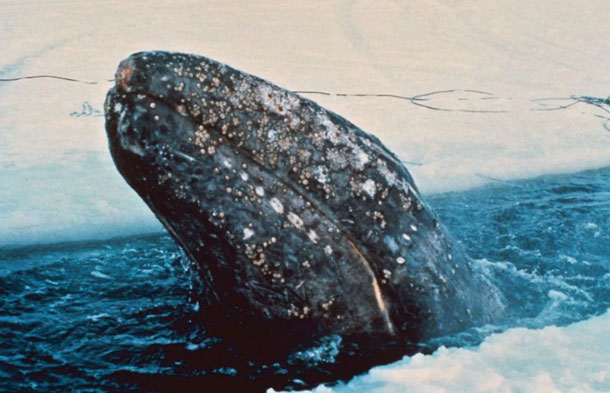
One of the three gray whales trapped in Barrow, Alaska back in 1988. (Photo: NOAA)
CURWOOD: Yeah because it was a whale of a story.
DYKSTRA: Well how about we mark that cliché for extinction.
CURWOOD: Fair enough Peter. Peter Dykstra’s with Environmental Health News, that’s EHN.org and the Dailyclimate.org. We’ll talk to you again real soon.
DYKSTRA: Alright Steve, thanks a lot. Talk to you soon.
CURWOOD: And there’s more on these stories at our website L-O-E dot O-R-G. And if you have a joke about climate change, tell us about it. Write us at comments at L-O-E dot O-R-G. That’s comments at L-O-E dot org.
Related links:
- Peter Dykstra: "What will it take on climate change?"
- New York Times | "Climate Change Is No Joking Matter. Except, This Week, It Was."
- October is the 30th Anniversary of the Gray Whales stuck in the ice
[MUSIC: Birdsong at Morning, “Kehena Shuffle” on Signs and Wonders, by Alan Williams, Blue Gentian Records]
CURWOOD: Coming up- trying to make do with little fresh water in the Gaza Strip. That’s just ahead on Living on Earth. Stay tuned!
ANNOUNCER: Support for Living on Earth comes from the Gordon and Betty Moore Foundation and from a friend of Sailors for the Sea, working with boaters to restore ocean health.
[CUTAWAY MUSIC: Birdsong at Morning, “Kehena Shuffle” on Signs and Wonders, by Alan Williams, Blue Gentian Records]
Gaza Water Crisis

Mohammad Nimnim wheels water jugs, to fill at the mosque at Beach refugee camp. (Photo: Abdel Kareem Hanna)
CURWOOD: It’s Living on Earth. I’m Steve Curwood.
Nowhere is the seemingly endless crisis between Israelis and Palestinians more acute than the Gaza strip, a hotly contested piece of land just 25 miles long and roughly 5 miles wide. Thousands of buildings were destroyed and more than 2200 Gazans were killed by Israeli forces in the 2014 war, with 71 deaths on the Israeli side. Twenty-one years ago, we sent reporter Sandy Tolan to Gaza to document the acute shortage of drinking water there, and back then he found that 85 percent of wells were too contaminated for human consumption. He recently returned and now that figure is up to 97 percent. Here’s his report.
TOLAN: The Shati refugee camp stretches for about a mile along Gaza’s Mediterranean coast. Shati means “beach” in Arabic, but it’s hard to find a cool ocean breeze here. The 87 thousand people squeezed into half a square kilometer of cement block dwellings are all refugees and their descendants. Of Gaza’s nearly two million people, three out of four are refugees - families forced to flee their towns and villages during the creation of Israel in 1948.
[WOMAN’S VOICE IN ARABIC]
TOLAN: Fatemah Nimnim was three when her family was driven out of the village of Hamama; she doesn’t remember much besides the refugee camp, where she now lives with three younger generations. They share three small rooms.
NIMNIM: Welcome! We are honored to meet you. May God give you health…
TOLAN: Today the entire family greets us in the front room – nineteen members of the Nimnim family. Most sit on the floor, backs against paint-chipped walls. They introduce themselves.
[NIMNM INTRODUCTIONS]
TOLAN: Today it’s 94 degrees and it’s really humid. It feels, unbearable.
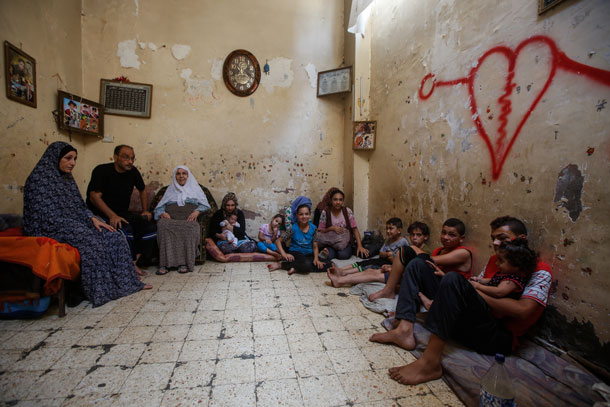
Fifteen members of the Nimnim family, at home in the beach refugee camp. (Photo: Abdel Kareem Hanna)
NIMNIM: It's hot, suffocating. There isn't enough space to sleep. There's no space at all, can you see.
TOLAN: There’s no fan, because electricity in Gaza comes just four hours a day, says Fatemah’s son, Atef Nimnim.
A. NIMNIM: Water and electricity? Forget about it. There isn’t any.
TOLAN: The water that comes out of the tap is way too salty to drink. That’s because the aquifer below our feet has been over-pumped so badly that seawater is flowing in.
[WHEEL CHAIR SOUNDS]
TOLAN: So, to quench the family’s thirst, 15-year-old Mohammad Nimnim piles plastic jugs into an old wheelchair and rolls it to the mosque, where sputtering taps provide the most basic necessity for life -- courtesy of Hamas.
[WATER SOUNDS]
TOLAN: For most people in Gaza, it’s not quite as dire. Two thirds of Gazans get water delivered by truck. Desalinated water is pumped into rooftop tanks via hoses.
[WATER GOING INTO A TANK]
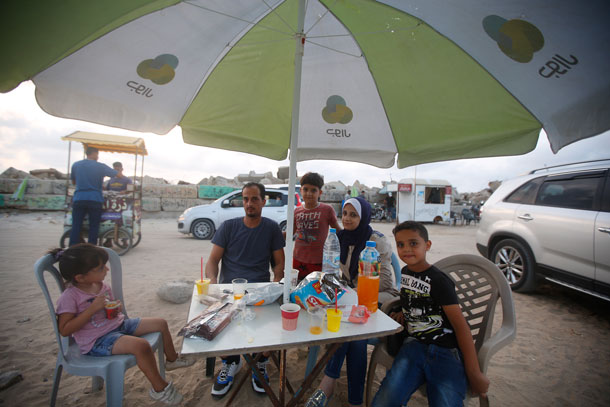
Children gather under an umbrella in the Shati (beach) refugee camp. (Photo: Abdel Kareem Hanna)
But when it comes to water in Gaza, better off is only by degree. The desalinated water is unregulated. And because this water has virtually no salt, it’s prone to fecal contamination, says former Palestinian deputy water minister, Rebhi Al Sheikh.
SHEIKH: And when it is a stored at the household water tank for many days more than 10 days then this level of contamination can reach up to 70 per cent.
TOLAN: That’s seven in ten people basically drinking poop, or e. coli if you prefer. And in terms of parts per million, UNICEF’s Gregor von Medeazza says the only really safe level is zero.
MEDEAZZA: So, already the presence of one is too much. Why? Because the moment you have one you actually have a potential for growth depending on how long you've got your water standing or sitting rather in those tanks.
TOLAN: I caught up with Gregor as he rode out to inspect new water projects in southern Gaza.
MEDEAZZA: The longer they are there the more you've got them protozoa you've got all sorts of other then little animals that actually start growing in your water and it just gets worse.
TOLAN: When children drink this water, they start getting the runs.
MEDEAZZA: So if you have repeated diarrhea the end result is actually your child would not grow to its full potential. You actually see children being stunted. What it also means is actually impediment in terms of brain development. You would actually have a measurable impact on the IQ of those children as they grow.
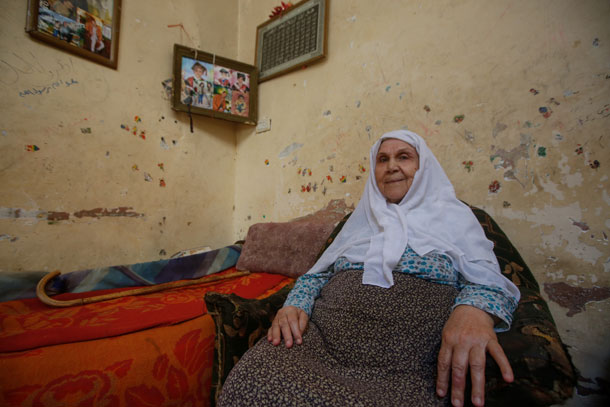
Fatemah Nimnim, family matriarch. (Photo: Abdel Kareem Hanna)
TOLAN: Late last year a British medical journal found an “alarming magnitude” of stunting among Gaza’s children. And that’s just one effect.
[HOSPITAL SOUNDS, KIDS CRYING]
Gaza pediatrician Mohammad Abu Samia says say there are so many others.
SAMIA: In the summer day the hospital is very very very busy.
TOLAN: Dr. Abu Samia takes us through the children’s ward in Al Nasser hospital in Gaza city. He stretches out his hand, touching a baby girl hooked up to a respirator. Alone in her hospital bed, she looks even tinier. Some of these children have recently had heart surgery. The overwhelmed doctor says he’s seeing a sharp rise in disease and illness in children like gastroenteritis from the dirty water.
SAMIA: Baby suffering from dehydration, from vomiting, from diarrhea, from fever.
TOLAN: And because of the extremely high nitrate levels in the water, the doctor is seeing other effects.
SAMIA: We have children, kidneys not working now.
TOLAN: Before, he tells me, they had 15 or 20 cases at any given time. Now it’s 40.
SAMIA: Every day I have in the hospital ten babies in machine, in hemodialysis because of renal failure. And the number increasing.
TOLAN: And so are cases of something called blue baby syndrome. The high nitrate levels deprive the blood of sufficient oxygen. And so some babies look – blue.
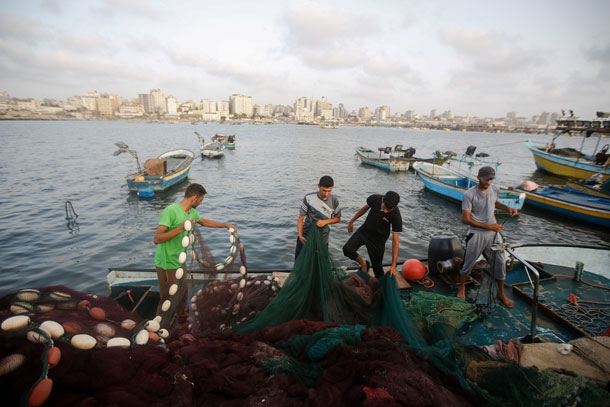
Fishermen in the Gaza harbor. (Photo: Abdel Kareem Hanna)
SAMIA: bluish lips bluish face bluish skin.
TOLAN: And blood the color of chocolate.
SAMIA: I see one or two kids the last ten years. But now I see five cases in the one year.
TOLAN: So. Sharp rises in Gastroenteritis. Stunted growth. Renal failure and hypertension from those high nitrate levels. Blue baby syndrome. And, Doctor Abu Samia says, he’s seen big increases in pediatric cancer – whether from water, the effects of three wars, he doesn’t know. And beyond the lack of water, he’s seeing the effects of malnutrition, which he blames on Israel’s economic blockade.
SAMIA: Nutrition is very bad. It is affected baby. Before siege, we don't have any patient with no malnutrition. Now we saw baby with marasmus. You know what is marasmus?
TOLAN: Marasmus is severe malnutrition, sometimes in newborn infants. Just skin and bone, the doctor says.
SAMIA: The last years increasing more and more.
TOLAN: Palestinian Health Ministry studies back up Dr. Abu Samia’s observations. They note a doubling of severe cases of diarrhea, especially in children, and “serious increases” in kidney disease, and in food and water borne diseases, including hepatitis A, salmonella, and typhoid fever. The British medical journal Lancet corroborates that shortages of clean, safe water have contributed to sharp rises in diarrhea among young children in the Gaza Strip. Diarrhea is the world’s second biggest killer of children under five.
HASNA: If you really want to change the lives of people you have to solve the water issue first.
TOLAN: Adnan Abu Hasna is a spokesperson for the UN agency for Palestinian refugees, UNRWA.
HASNA: Otherwise that you will see huge collapse of everything in Gaza.
TOLAN: Already Gaza is widely considered the world’s largest open-air prison.
HASNA: You can keep people in prison, surviving and giving them the minimum drops of water. Little of electricity, little of hope. Now I can tell you Gazans reach the level that people are thinking there is no tomorrow in Gaza. The. Kind of the dream you are not allowed to dream because your dreams will never be achieved will never be a reality.
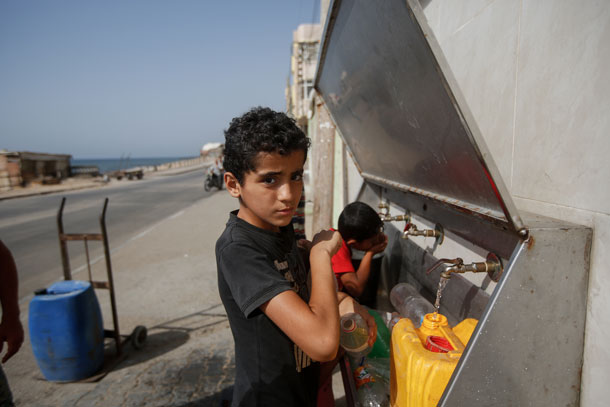
Children drink and fill water jugs at a mosque in Gaza City. (Photo: Abdel Kareem Hanna)
TOLAN: It may seem that Gaza’s torments are completely contained by layers of fences, locked gates, patrolling Israeli drones, war planes, and international indifference. But that’s not true.
One example: Because Gaza’s power plant runs only four hours a day, its sewage plant is basically useless. So, 110 million liters of raw and poorly treated sewage flow directly into the Mediterranean, every day –here on this beach, long pipes spew brown water into the ocean, just ten miles from Gaza City.
BROOMBERG: They are carried by the currents and north and the response was closing the beaches in Gaza itself.
TOLAN: Gidon Bromberg is director of Ecopeace Middle East, based in Tel Aviv.
BROOMBERG: A young five-year-old boy, unfortunately his family took him and the boy swallowed some water and within ten days he was dead. A virus got to his brain.
TOLAN: The child’s name was Mohammad Al-Sayis and Bromberg says some of the misery in Gaza does go beyond its borders.
BROOMBERG: It's led to the closure of beaches directly on the Israeli side of Sikkim.
TOLAN: Authorities even had to close an Israeli desalination plant for a time – because, who wants to try to desalinate water with poop in it?
Israelis, Bromberg says, need to wake up to the unfolding humanitarian disaster in Gaza.
BROOMBERG: It's a ticking time bomb. We have a situation where two million people no longer or no longer have access to potable groundwater. When people are drinking unhealthy water then disease is a direct consequence Should pandemic disease break out in Gaza people will simply start moving to the fences. and they won't be moving with stones or with rockets they'll be moving with empty buckets desperately calling out for clean water.
[PROTEST SOUNDS]
TOLAN: Assigning blame for the plight of Gazans is not exactly simple. Take the fact that three percent of Gaza’s drinking water wells are actually drinkable. Is that because Gaza’s citrus farmers pumped too much? Or because Israeli agricultural settlers depleted a deep pocket of fresh water before they left Gaza in 2005? Or the simple fact that Gaza’s population quadrupled in a matter of weeks when towns and villages fell to Israel in 1948?
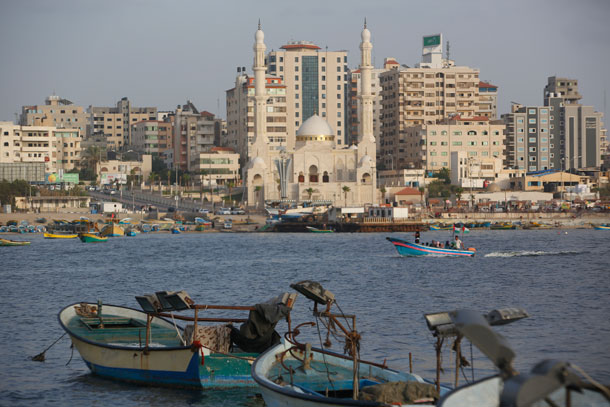
The Gaza harbor. (Photo: Abdel Kareem Hanna)
And how about the food and water borne diseases? That’s in part because the power is shut off for 20 hours a day. Do we blame Israel and Egypt for withholding fuel deliveries? Or Israel, for bombing water and sewage infrastructure in Gaza during the 2014 war? Or the fight between Hamas and the Palestinian Authority, which deprives Gazans of critical medicines?
And what about Israel’s economic blockade of Gaza, which human rights groups say contributes to worsening poverty, skyrocketing unemployment and child malnutrition?
A peace deal could have connected Gaza to the West Bank, where the vast Mountain Aquifer is big enough to end Gaza’s water crisis. As it is, there is no peace. The two Palestinian territories are splintered. And Israel has effective control over of the water.
Critics say Israel could solve the whole problem by simply building big water and power lines into Gaza. But Israeli officials say they are already sending water to Gaza – and to do more would be rewarding Gaza’s bad actors.
SHOR: My name is Ori Shor. I am the spokesperson for the Israeli Water Authority. What's going in Gaza is a real catastrophe. The situation there is unbearable but it's also frustrating at least from our point of view. because it's a bit difficult to help someone that doesn't want to help themselves. The problem in Gaza is really that there Hamas people do not do nothing in order to try even to solve the problem.
The obligation of Israel in this agreement that we have. To provide a certain amount of water to Gaza and certain amount of water to the West Bank. Israel is providing it and they're providing more than twice the amount that we are obliged by our agreement.
That amount is just a fraction of the clean water Gazans need every day. And so, the situation in Gaza continues to deteriorate. Humanitarian groups estimate that Gaza will become uninhabitable by 2020 – barely a year from now. To avoid that international relief agencies, and the Palestinian water authority, are working on a network of big sewage and desalination plants.
MOAMAR: This is the feed water from the storage tank…
TOLAN: This is Kamal Abu Moamar, manager of the South Gaza Desalination plant. It’s a small first step. Eventually there would be a half dozen, along with big sewage plants -- $500 million dollars with, all funded by international donors. But my visit doesn’t inspire confidence. It’s quiet. We can hear the birds chirping in the rafters above the idle plant floor.

Families flock to the beach at dusk, Gaza City. (Photo: Abdel Kareem Hanna)
TOLAN: So this plant requires a lot of electricity.
MOAMAR: Yeah.
TOLAN: You don't have more than four hours a day these days.
MOAMAR: At this time, we don’t have but we hope. Many of our ministers say that they will solve this problem. But we don't know when. Or how.
TOLAN: Basically, the half billion-dollar plant relies on two things that Gazans haven’t had in a long time: reliable power, and guarantees from Israel that it won’t bomb these plants in the next war.
MOAMAR: The Israeli can do anything she wants.
TOLAN: Mazen Al Binna, of the Hamas government’s water authority.
BINNA: Nobody can tell Israel that you are doing the wrong thing. Even Israel doing everything against international law but nobody can prevent Israel doing everything she wants to do.
TOLAN: It’s true that Israeli war planes have bombed the Gaza power plant repeatedly in recent wars, along with other critical infrastructure. Yet an internal Israeli army document promoting the desalination plan suggests Israel would be on board. But there’s no official word. An Israeli army spokesman would not return more than a dozen calls from Living on Earth. So I put the question to Gregor von Medeazza, the water expert from UNICEF.
TOLAN: Isn't that a risk?
MEDEAZZA: Any infrastructure is a risk in a context like Gaza. But then the question then obviously is what are the other options? Really what is the way forward? If we actually don't plan that would basically say we come to a standstill. And of course we cannot come to a standstill because we have two million people in the Gaza Strip that require and deserve better services.
[SOUNDS OF GAZA PIER]
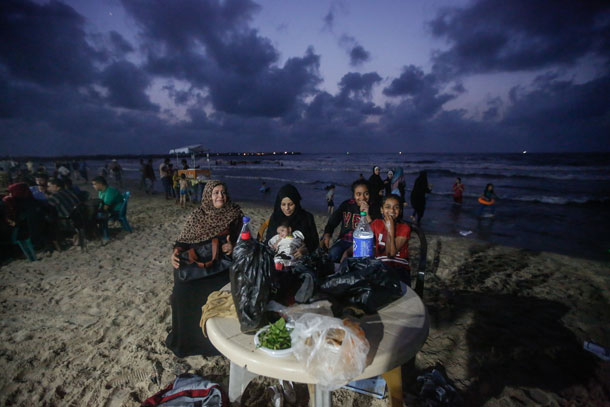
A family enjoys a respite from the sweltering heat of the beach refugee camp. (Photo: Abdel Kareem Hanna)
TOLAN: On a dusky summer night, on a stony spit of land in the middle of Gaza Harbor, five of those two million people try to enjoy a few minutes of peace. All around Ahmad and Rana Dilly and their three young children, the harbor ripples with life: fishermen hauling up their nets, kids posing for selfies on broken concrete blocks and rebar, remnants of an old bombing raid.
[NIMNIM FAMILY]
Ahmad and Rana invite me to join them under their beach umbrella. We sit in plastic chairs. Rana pours us mango soda; with a smile, Ahmad insists that I sample some chocolate wafers. Their three young children eye me shyly, nibbling on chips.
The Dillys have the same problems as many Gaza families. Ahmad’s a money changer. An Israeli missile destroyed his shop in 2014. He rebuilt it. And, like most Gazans, they have to contend with the salty water from the taps, and the inherent risks of disease from the trucked water they rely on. But these problems mean little to them compared to their wish to feel safe, and to enjoy fleeting moments like this of living as a normal family.
DILLY: I want just to change something for my family and my kids. I want to do something, to get them to see something different. I’m looking for my family just to feel safe.
In the distance, we hear an explosion. Ahmad pauses for a short moment, then ignores it. He says, I come here, just to forget everything…
For Living on Earth, I’m Sandy Tolan in the Gaza Strip.
Related link:
Reporter Sandy Tolan’s Website
CURWOOD: Coming up – The necessity defense for climate civil disobedience. That’s just ahead on Living on Earth.
ANNOUNCER: Funding for Living on Earth comes from you our listeners and United Technologies, combining passion for science with engineering to create solutions designed for sustainability in aerospace, building industries, and food refrigeration. UTC companies such as Otis, Carrier, Pratt and Whitney, and UTC Aerospace systems are helping to move the world forward. You can learn more about United Technologies by tuning into the Race to Nine Billion podcast; listen at race to nine billion dot com. That’s race to nine billion dot com. This is PRI, Public Radio International.
[CUTAWAY MUSIC: Glen Velez, “Assyrian Rose” (Cut #3) on Assyrian Rose by GlenVelez, Creative Music Prod. Records]
Acquitted For Climate Convictions
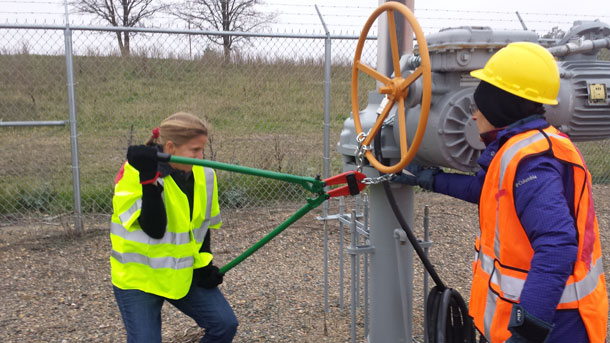
Emily Johnston uses bolt cutters to cut the chain on an emergency shut-off valve on Enbridge Line 4. (Photo: Climate Direct Action - www.shutitdown.today)
CURWOOD: It’s Living on Earth. I’m Steve Curwood.
On October 11th 2016, climate activists Emily Johnston and Annette Klapstein took bolt cutters to chains on 2 Enbridge pipelines in northern Minnesota.
[SFX: CHAIN CLINKING, SOUND OF CHAIN BEING CUT]
CURWOOD: Then they turned emergency shut-off valves for Lines 4 and 67.
WOMAN: line 67 is shut down!
CURWOOD: The two women and three other so-called “Valve Turners” temporarily stopped the flow of most of the oil coming from Canada’s tar sands that day. A protester who acted in North Dakota spent months in prison and the pair who acted in Minnesota also faced felony charges. Ms. Johnston, an editor and poet, and Ms. Klapstein, a retired attorney were charged with damaging the Enbridge pipelines and prepared to mount a “climate necessity defense.” But on October 9th, in the middle of their trial, a Minnesota judge abruptly acquitted them of all charges, and they join me now from Seattle, Washington. Welcome to Living on Earth!
KLAPSTEIN: Thank you.
EMILY: Thank you very much, Steve.
CURWOOD: How does it feel to have these felony charges thrown out? Annette?
KLAPSTEIN: I think we all have mixed feelings about that. I've been feeling giddy with happiness that we are not going to jail, and quite frankly that I'm off bail and may have the opportunity to do civil disobedience again because I had to be very careful while out on bail because if I got arrested it could be revoked and I could spend all of my time in the Clearwater County Jail awaiting trial. But we're disappointed that we did not get to put on the climate necessity defense that we wanted to with the very well respected experts that we had lined up to testify for us, like Dr. James Hansen, former climate scientist from NASA, and Bill McKibben. So, it's a mixed bag.
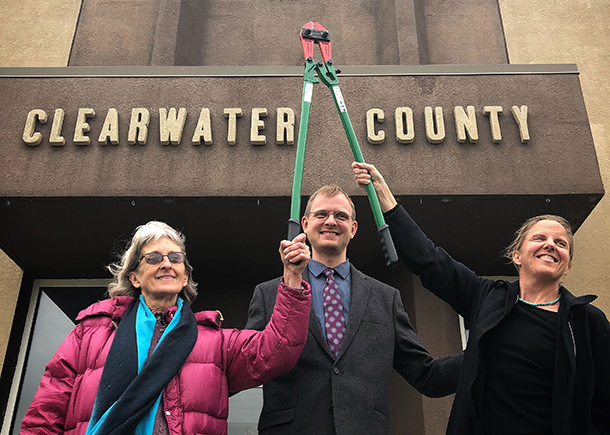
From left: Annette Klapstein, Ben Joldersma and Emily Johnston celebrate their acquittal, and the return of their bolt cutters, outside the Clearwater County Courthouse in Bagley, Minnesota on October 9th, 2018. (Photo: Climate Direct Action - www.shutitdown.today)
CURWOOD: Emily?
JOHNSTON: Yeah, I'll go being stronger about it than that and say that I was really heartbroken, not so much by the acquittal, of course, which is a good thing. It was the sort of second best scenario we could have had, but by the denial of our expert witness testimony on climate change and on civil disobedience. It would have been the dream trial. It could have made a really big difference. So, the thought that this kind of trial might happen in that courtroom in front of those jurors and that might set a precedent that would really have an impact nationally on the climate change debate seemed like a really important thing to me. And of course, until four days before trial began it looked very much like it was going to happen. So, it's a real shame that that it did not.
CURWOOD: Now, as I understand it you had asked the judge to let you use the necessity defense.
JOHNSTON: Yes, and he had granted that to us back in October of 2017, and in fact, he had copies of our expert witness list for about the last year and a half. So, any point in that time period he could have constrained us, constrained the number of witnesses, said you can't talk about this or that, and he chose not to. So, the fact that he did that four days before trial again was stunning. The lawyers couldn't have been more surprised. We couldn't have been more surprised. Until that moment he had been very very reasonable and it seemed like all systems were go. And to be clear, the thing about that that was so striking apart from its suddenness, was the fact that normally speaking, defendants do not have any burden of proof. It's the prosecution that has a burden of proof normally. But, because we are going to use a necessity defense and say that what we did was essentially necessary under the circumstances that we find ourselves in to prevent the greater harm of climate change, we did have the burden of proof, and all of a sudden he did knock out our ability to defend ourselves essentially because who was going to listen to a poet, a retired lawyer, and a software engineer from Seattle on climate change? We're not scientists. We have no authority. So, no matter how articulate we had been it wouldn't have had anything like the same impact as the former head of the NASA Goddard Space Center talking about climate change and how urgent it is, or about Minnesota scientists talking about how urgent it is and how much is already changing in Minnesota. So, again, we had no ability defend ourselves without experts to testify to those things.
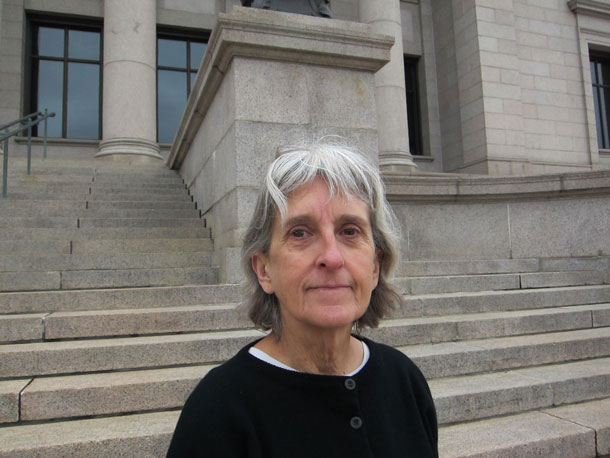
Annette Klapstein, a member of the Seattle Raging Grannies, says now she’s off bail she’s looking forward to once again engaging in climate civil disobedience. (Photo: Climate Direct Action - www.shutitdown.today)
CURWOOD: And the software engineer, your co-defendant was...?
KLAPSTEIN: That was Ben Joldersma, a young father of three who was our support person. Our support people were all arrested. They went in knowing that that was a possibility, but it was certainly our hope when we were planning the action that they would not be arrested.
JOHNSTON: So, we're very very happy that he's acquitted and home with his young family. We're happy that he's acquitted, but I personally am very sorry he didn't get to testify. In the necessity defense hearing in August a year ago, when he testified there was not a dry eye in the room.
KLAPSTEIN: He talked about his young children and what they were facing.
CURWOOD: And then the case becomes even more confusing. I guess because the judge says, on the one hand, you can't have witnesses to make your case, and then he proceeds to go ahead to acquit you of the charges.
KLAPSTEIN: Right. That was after the prosecutor had presented his case which was only two witnesses, the sheriff who arrested us and local Enbridge employee. And all he proved was that we had broken some chains that were holding the lock into the enclosure where the emergency shut off valve was. And we never disputed that. So, we were charged under a statute which was one of the sort of enhanced penalties statutes that are being shoved through state legislatures right now by the fossil fuel industry to give them further penalties against protesters, and the statute we were charged under was specifically damage to pipelines. And the judge ruled and he was correct that the prosecutor had not proved that we had damaged the pipeline in any way.
JOHNSTON: Yeah, and essentially he was ruling that there wasn't evidence for a reasonable jury to convict us, basically. But that was because of course we hadn't damaged the pipeline.
CURWOOD: I'm going to ask you to speculate a bit, both of you Annette and Emily, about Judge Robert Tiffany, and the decisions that he made in your case. How do you think the judiciary might have been influenced by outside forces - politics, sentiment, the fossil fuel industry?
JOHNSTON: This is Emily. In terms of what kind of pressures he may have been under, or what he may have been thinking, or whether his mind might have changed about what kind of precedent he wanted to set and so forth, it's impossible to know and it's distressing and it's certainly something we've been wondering about. He seems like a very reasonable guy. He gave us the necessity defense. He wanted to hear what we had to say and he wanted to let the jury hear it. So, the about face was quite extreme.
KLAPSTEIN: We know for sure that Enbridge provides something like two thirds of the budget of that county, so they obviously have some influence direct or indirect, we don't know. I mean, we have no way to know what may or may not have happened behind the scenes, but they fossil fuel companies have terrible amounts of influence and power in this country, and that's why we have to fight them in the ways that we have to fight them because they do own and control our political system on all levels.
CURWOOD: To what extent did you understand when you did this direct action that law enforcement could bring felony charges against you? Annette?
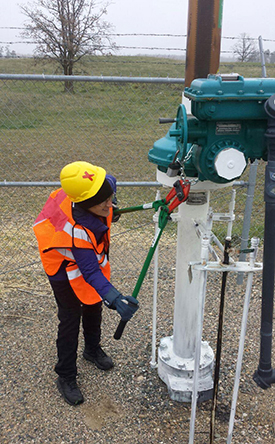
Annette Klapstein cuts the chain on Enbridge Line 67. (Photo: Climate Direct Action - www.shutitdown.today)
KLAPSTEIN: We absolutely knew that that was not only a possibility but a strong probability, and we accepted that risk. I personally feel I'm 66 years old and I feel that it is my job as an elder and it is my job because I am an old white woman who has the privilege of not having the cops show up and shoot me on sight if I do something like that, that it really is my job to step up and do these kinds of things. I know from my young activist of color friends that it's far more risky for them. It's far more risky just with the police showing up that they can be in danger of their lives, and we know that the criminal justice system is far more likely to treat them harshly. We can look right now at what is going on with the prosecutions of indigenous folks who stood up at Standing Rock and often were arrested for no more than standing in prayer and yet are getting felony convictions right now and getting very harsh sentences. So, I have been saying this for the past two years as I go around the country, I implore older white folks to show up and stand up and do these kinds of actions. This is for your grandchildren. It's for all future generations and you're in a good position to be able to do that and have lesser consequences.
CURWOOD: Now, some would say why go to the trouble of shutting off a pipeline and risking all the prison time when obviously that will only stop the flow of oil for a few hours at most?
JOHNSTON: Civil disobedience doesn't work immediately like that. It's not like you turn off the pipeline and you really expect they're going to keep it off forever and ever because you are so brave. [LAUGHS]
But the thing is, when people step up and do something like that and take that kind of risk, it makes other people, for one thing, listen to us in a different way. If we're just held in protests and just writing letters and making phone calls, it's pretty easy to for folks to shut down and not pay attention. But when you've been willing to take a lot of legal risk onto yourself, they do tend to stop and say, hey, why would you do such a crazy thing, and that gives you a chance to tell them why you would do such a crazy thing. So, that's part of it and then the other part of it also, honestly, is like when you do something like that - and there were five of us - and we managed to shut off the equivalent of 15 percent of the US daily oil used that day with nothing more than a pair of bolt cutters and some research. When you do something like that you make it clear to people that those companies need our implicit consent in order to operate. They have millions of miles of pipeline. They have oil trains coming through all of our communities. If we know that if we let them continue on with business as usual, they are destroying the world as we know it quite literally. If we can step up and stop that, whether it's chaining ourselves in governors' offices, whether it is swarming onto sites where they're trying to build new infrastructure like we saw at Standing Rock, whether it's shutting off pipelines or blockading oil trains, there are numerous ways that people can stand up and make a real difference and make it clear that we are not going to go down without a fight.
CURWOOD: Emily and Annette, when one thinks civil disobedience in this country, one thinks Henry David Thoreau, Martin Luther King Jr. To what extent do you feel connected to those efforts of the past?
KLAPSTEIN: Very much so. I mean when you have unjust laws or unjust policies, you sometimes have to break laws in order to call the attention you need to get things changed. There's often this idea that it's a bad thing to break the law, but I can say as a former lawyer that just because something is legal does not mean it was moral. There have been many many laws in the past that have been totally immoral, slavery being a good example.
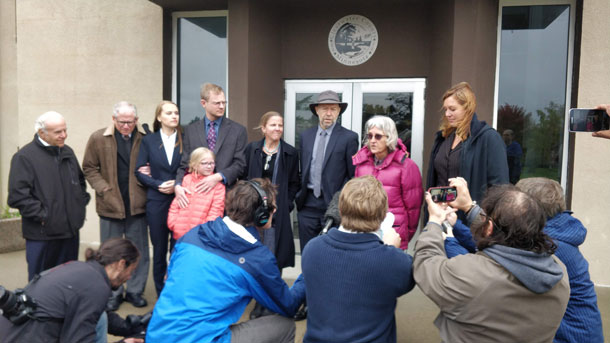
Emily Johnston, Annette Klapstein and Ben Joldersma, surrounded by supporters, lawyers and the media outside the Clearwater County Courthouse on the day of their acquittal, October 9th, 2018. (Photo: Climate Direct Action - www.shutitdown.today)
JOHNSTON: This is Emily. I was going to say also, I mean I read on civil disobedience when I was a kid and certainly read about Martin Luther King and Gandhi and figures like that, and I do feel that that's an incredibly important example and tradition. The other thing I think about with regard to climate change, more recently I've been thinking a little bit about people like Raoul Wallenberg, the Swedish diplomat who saved many thousands of Jews during World War II. And in a way, the climate change fight has a lot in common with that because so many people get overwhelmed and think well there's catastrophe coming, I can't do anything about it. But you just get up every day and you do the best you can, and you save what you can save. And there's still quite a lot that we can save, and so can we save life as we know it, probably not. Can we save everybody? Oh, definitely not. We already have failed to do that. But we can get up every day and we can save a tremendous amount, and we have a lot of power that way and its power we need to utilize.
CURWOOD: I was going to ask you, Annette. Obviously you're concerned enough about climate to risk spending time in prison. What keeps you from total despair?
KLAPSTEIN: There are days when it is total despair, but I feel I have no option but to continue to fight for what there is still to fight for, and as Emily says, it's not absolute. Anything we can save is worth saving, and I often say what are my alternatives? Am I just going to sit home and watch TV and wait for the world to end? I absolutely am not, so at worst I can go down fighting with the best people I know and that is worth doing. I remember that Alice Walker said resistance is the secret of joy and I have found that to be absolutely true. When you exercise your power and do everything that you can to stop a great evil, it is a joyful thing.
CURWOOD: Emily Johnston is a poet and Annette Klapstein is a retired attorney, and they are two of the five valve turners. Thank you so much for taking the time with us today.
JOHNSTON: Thank you, Steve.
KLAPSTEIN: Thanks for having us.
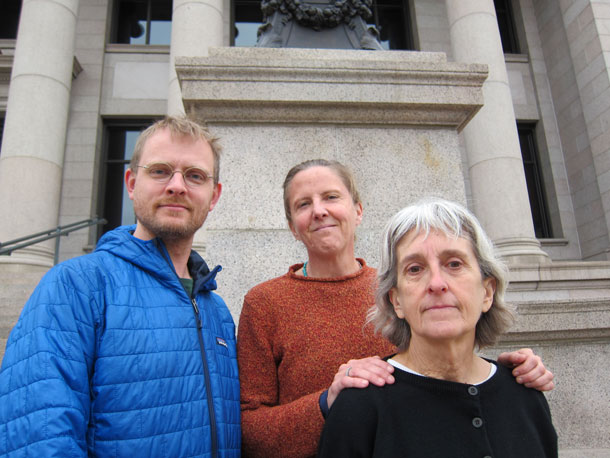
Ben Joldersma, Emily Johnston and Annette Klapstein outside the Minnesota State Supreme Court in Minneapolis. (Photo: Climate Direct Action - www.shutitdown.today)
CURWOOD: The valve turners chose to get arrested to make the case that climate change is more of a crime than acts of civil disobedience against it. And without getting arrested 21 young people are challenging in court the government’s role in global warming emissions. Their lawsuit, known as Juliana Vs. United States, was set to go on trial in Oregon on October 29, but on October 19th Supreme Court Chief Justice John Roberts abruptly halted the case at the request of the Trump Administration. As we prepared this broadcast it was unclear if this is merely a delay or if the high court will move to dismiss the case altogether before evidence is taken.
Statement from Tracie Kenyon of Enbridge
“Enbridge maintains that the actions taken by individuals in 2016 to trespass on our facility and attempt to tamper with energy infrastructure were reckless and dangerous. The individuals involved in these activities claimed to be protecting the environment, but they did the opposite and put the environment and the safety of people at risk -- including themselves, first responders and neighboring communities and landowners.
“Our preference is always to seek to resolve differences of opinion through dialogue – peacefully and respectfully. We don’t tolerate trespassing, vandalism, or mischief, and Enbridge will seek to prosecute those involved to the fullest extent of the law.”
Related links:
- The Valve Turners’ website, “Shut It Down: Climate Direct Action”
- The Guardian | “Charges dropped against climate activists who tried to shut down pipelines”
- Watch: the Valve Turners short film
- The New York Times Magazine | “‘I’m Just More Afraid of Climate Change Than I Am of Prison’”
BirdNote®: Saw-whet Owls Hoot And Hoot

Saw-whet owls are nocturnal and roost in dense forest. (Photo: Gregg Thompson)
[BIRDNOTE THEME]
CURWOOD: It’s the season of Halloween and the Day of the Dead, and that might have people thinking about ghosts and goblins. But for BirdNote®’s Mary McCann it’s the season for owls. And far from spooky the tiny Saw-whet Owl is just 8.5 inches long and weighs less than a stick of butter.
[BIRDNOTE THEME]
[Advertising call of Northern Saw-whet Owl recorded by D. Ross]
MCCANN: This past summer, a man trying to sleep got really annoyed with his neighbor on the other side of the woods who, he thought, kept backing up a big truck. The next day he grumbled, “What were you doing? It kept me up most of the night!” “Oh, you musta heard the Saw-whet Owl!” the neighbor said.
[Repeat advertising call of Northern Saw-whet Owl recorded by D. Ross]
Named for what, to some, sounds like a saw being sharpened on a stone, Northern Saw-whet Owls are common in forests across southern Canada and the northern US. At this time of year, many move southward, making a large concentration especially in the region of the Great Lakes.

The Saw-whet owl averages eight inches in length, about the same size as the common robin. (Photo: Dave Wendelken)
To our ear, the “advertising” call of the male, made mostly in spring and summer, sounds awfully repetitive. But researchers think female Saw-whets hear variety. See if you can. Here are two males – listen carefully to the pacing of their hoots:
Here’s the first [recorded by D. Ross].
Here’s the second [recorded by G.A. Keller].
Some give a prelude to their advertising call [recorded by T.G. Sander].
In the fall, the birds make a “skew” call [recorded by S. Weidensaul].
And here’s a “twitter” call with a snap of the bill [recorded by W.W.H. Gunn]
Quite a variety for one of North America’s smallest owls, the Northern Saw-whet…
[Advertising call, recorded by G.A. Keller]
###
Written by Chris Peterson
Sounds of the Northern Saw-whet provided by The Macaulay Library of Natural Sounds at the Cornell Lab of Ornithology, Ithaca, New York. First advertising call recorded by D. Ross. Second advertising call recorded by G.A. Keller. Prelude to advertising call recorded by T.G. Sander. Skew call recorded by S. Weidensaul. Twitter call recorded by W.W.H. Gunn.
Producer: John Kessler
Executive Producer: Chris Peterson
© 2005-2018 Tune In to Nature.org October 2018
Narrator: Mary McCann
CURWOOD: For photos of the adorable Saw-whet owl head on over to our website, it’s a hoot!
Related links:
- Learn more on the Birdnote website
- The Saw-whet Owl – The Cornell Lab of Ornithology
[MUSIC: Michael Johnathon, “Moon Fire” on Moon Fire-The Banjo Album, Poet Man Records]
CURWOOD: Living on Earth is produced by the World Media Foundation. Our crew includes Naomi Arenberg, Bobby Bascomb, Thurston Briscoe, Savannah Christiansen, Jenni Doering, Jaime Kaiser, Don Lyman, Lizz Malloy, Aynsley O’Neill, Jake Rego, Sarah Rappaport, Adelaide Chen and Jolanda Omari.
Tom Tiger engineered our show. Special thanks this week to Valve Turner documentarian Steve Liptay.
Alison Lirish Dean composed our themes. You can hear us anytime at L-O-E dot org, iTunes and Google play- and like us, please, on our Facebook page - PRI’s Living on Earth. And we tweet from @livingonearth. I’m Steve Curwood, Thanks for listening!
ANNOUNCER: Funding for Living on Earth comes from you our listeners and from the University of Massachusetts, Boston in association with its School for the Environment, developing the next generation of environmental leaders. And from the Grantham Foundation for the Protection of the Environment, supporting strategic communications and collaboration in solving the world’s most pressing environmental problems. Support also comes from the Energy Foundation, serving the public interest by helping to build a strong clean energy economy.
ANNOUNCER 2: PRI, Public Radio International.
Living on Earth wants to hear from you!
Living on Earth
62 Calef Highway, Suite 212
Lee, NH 03861
Telephone: 617-287-4121
E-mail: comments@loe.org
Newsletter [Click here]
Donate to Living on Earth!
Living on Earth is an independent media program and relies entirely on contributions from listeners and institutions supporting public service. Please donate now to preserve an independent environmental voice.
NewsletterLiving on Earth offers a weekly delivery of the show's rundown to your mailbox. Sign up for our newsletter today!
 Sailors For The Sea: Be the change you want to sea.
Sailors For The Sea: Be the change you want to sea.
 The Grantham Foundation for the Protection of the Environment: Committed to protecting and improving the health of the global environment.
The Grantham Foundation for the Protection of the Environment: Committed to protecting and improving the health of the global environment.
 Contribute to Living on Earth and receive, as our gift to you, an archival print of one of Mark Seth Lender's extraordinary wildlife photographs. Follow the link to see Mark's current collection of photographs.
Contribute to Living on Earth and receive, as our gift to you, an archival print of one of Mark Seth Lender's extraordinary wildlife photographs. Follow the link to see Mark's current collection of photographs.
 Buy a signed copy of Mark Seth Lender's book Smeagull the Seagull & support Living on Earth
Buy a signed copy of Mark Seth Lender's book Smeagull the Seagull & support Living on Earth

